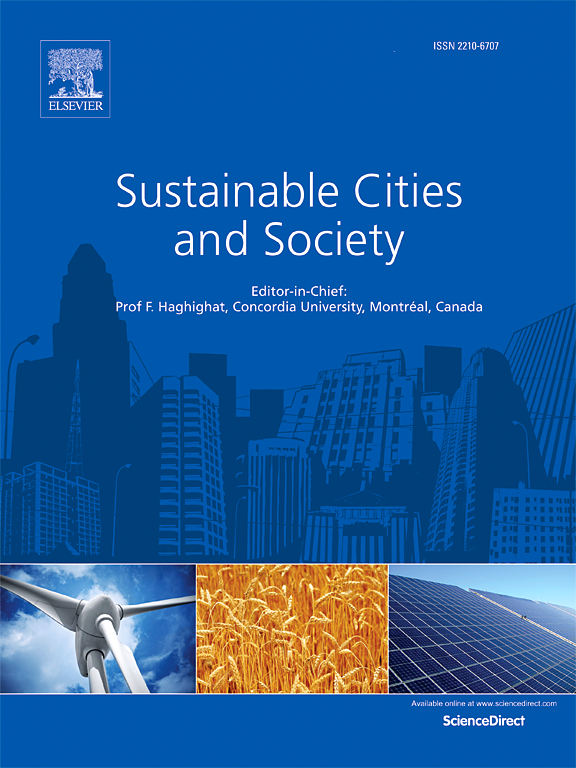基于多源数据和局部空间模型的电动汽车充电需求、影响因素及空间效应分析
IF 10.5
1区 工程技术
Q1 CONSTRUCTION & BUILDING TECHNOLOGY
引用次数: 0
摘要
为缓解电动汽车(EV)普及带来的充电难问题,本文对充电需求及影响因素进行了深入分析。根据充电需求的空间分布,将目标区域划分为多个沃罗诺不等边多边形,并定性分析建筑环境和社会经济因素的空间特征。然后,通过多重共线性检验和空间相关性检验,剔除冗余因素,探索充电需求和影响要素的空间聚类和相关性。提出了一个多尺度地理加权回归和空间自回归模型(MGWR-SAR)来研究这种复杂性质。中国重庆的实证研究表明,相邻单元的充电需求呈现明显的高-高-低聚类模式,并受到低SOC电动汽车、人口密度、停车场密度、交通条件等因素的显著影响。空间影响程度和尺度随因素和区间的不同而不同,其中人口密度和路网密度的空间尺度为局部影响,具有较强的空间异质性;低 SOCs 电动汽车、土地利用混合和房价的空间尺度接近于全局影响。高需求地区和充电高峰期的充电需求空间依赖性强于低需求和非高峰期。充电需求和影响因素存在空间依赖性和异质性,这使得 MGWR-SAR 优于其他模型。这些发现将为预测充电需求和优化充电站提供支持。本文章由计算机程序翻译,如有差异,请以英文原文为准。
Analysis of charging demands, influencing factors and spatial effects of electric vehicles based on multi-source data and local spatial models
In order to alleviate the difficulty of charging caused by the popularization of electric vehicles (EVs), this paper conducts an in-depth analysis of the charging demands and influencing factors. According to the spatial distribution of charging demands, the target area is divided into more Voronoi unequal polygons, and the spatial characteristics of the built environment and socio-economic factors is qualitatively analyzed. Then, multicollinearity and spatial correlation tests are employed to eliminate redundant factors and explore the spatial clustering and correlation of charging demands and impact elements. A multi-scale geographically weighted regression and spatial autoregressive (MGWR-SAR) model are proposed to investigate such complex properties. An empirical study in Chongqing, China has shown that the charging demands in adjacent units exhibit obvious high-high and low-low clustering patterns, and are significantly influenced by the EVs with low SOCs, population density, parking lots density, transportation conditions, etc. The spatial impact degrees and scales vary with the factors and intervals, wherein the spatial scales of population density and road network density are local, with strong spatial heterogeneity; EVs with low SOCs, land use mixing and housing prices are close to global impacts. The spatial dependence of charging demand in high demand areas and charging peak periods is stronger than that in low demand and off-peak. There are spatial dependence and heterogeneity in charging demands and influencing factors, which makes MGWR-SAR superior to other models. These findings will provide support for predicting charging demands and optimizing charging stations.
求助全文
通过发布文献求助,成功后即可免费获取论文全文。
去求助
来源期刊

Sustainable Cities and Society
Social Sciences-Geography, Planning and Development
CiteScore
22.00
自引率
13.70%
发文量
810
审稿时长
27 days
期刊介绍:
Sustainable Cities and Society (SCS) is an international journal that focuses on fundamental and applied research to promote environmentally sustainable and socially resilient cities. The journal welcomes cross-cutting, multi-disciplinary research in various areas, including:
1. Smart cities and resilient environments;
2. Alternative/clean energy sources, energy distribution, distributed energy generation, and energy demand reduction/management;
3. Monitoring and improving air quality in built environment and cities (e.g., healthy built environment and air quality management);
4. Energy efficient, low/zero carbon, and green buildings/communities;
5. Climate change mitigation and adaptation in urban environments;
6. Green infrastructure and BMPs;
7. Environmental Footprint accounting and management;
8. Urban agriculture and forestry;
9. ICT, smart grid and intelligent infrastructure;
10. Urban design/planning, regulations, legislation, certification, economics, and policy;
11. Social aspects, impacts and resiliency of cities;
12. Behavior monitoring, analysis and change within urban communities;
13. Health monitoring and improvement;
14. Nexus issues related to sustainable cities and societies;
15. Smart city governance;
16. Decision Support Systems for trade-off and uncertainty analysis for improved management of cities and society;
17. Big data, machine learning, and artificial intelligence applications and case studies;
18. Critical infrastructure protection, including security, privacy, forensics, and reliability issues of cyber-physical systems.
19. Water footprint reduction and urban water distribution, harvesting, treatment, reuse and management;
20. Waste reduction and recycling;
21. Wastewater collection, treatment and recycling;
22. Smart, clean and healthy transportation systems and infrastructure;
 求助内容:
求助内容: 应助结果提醒方式:
应助结果提醒方式:


